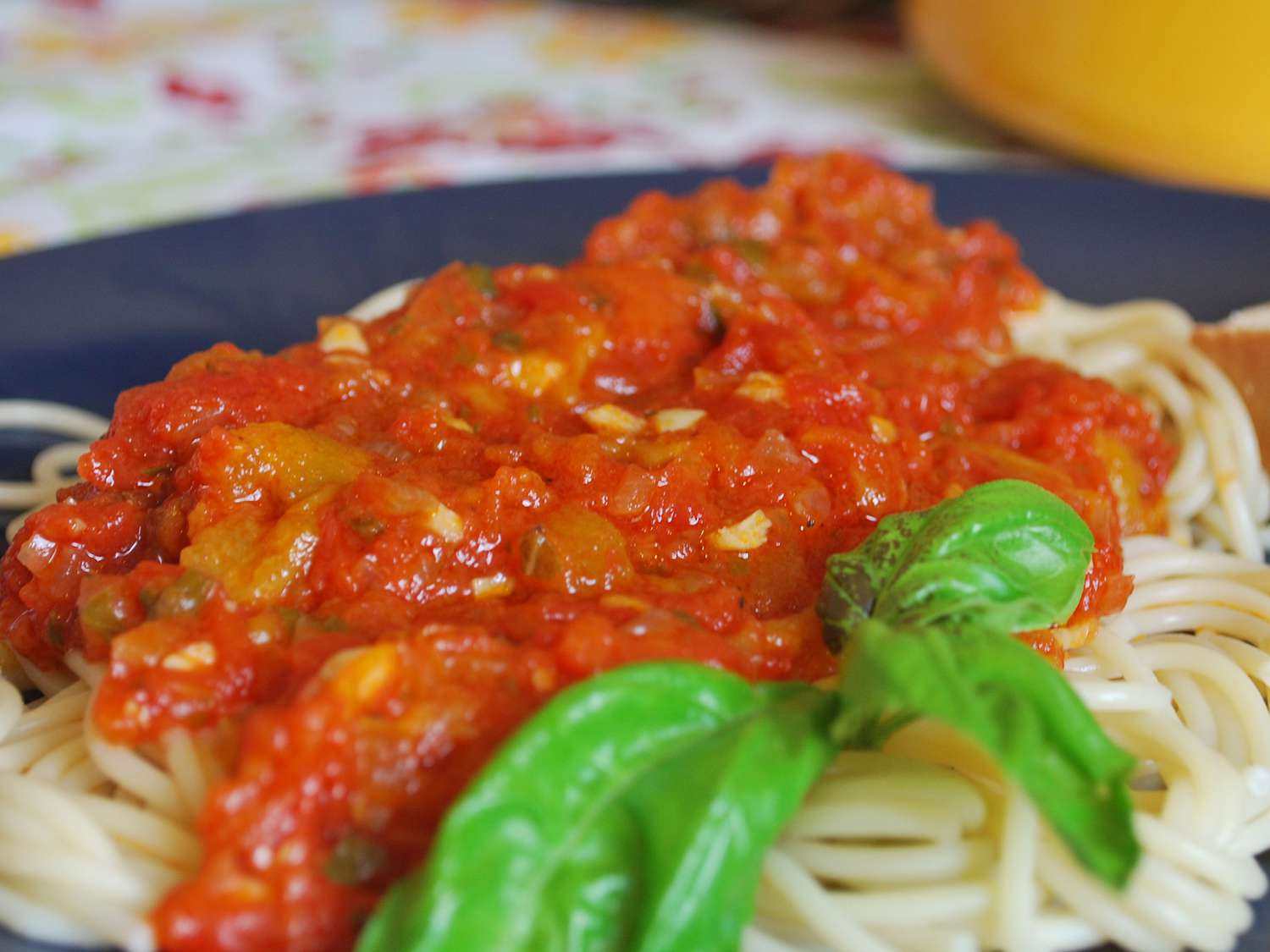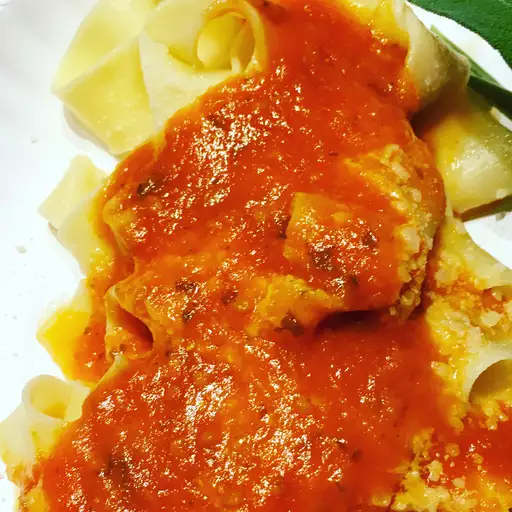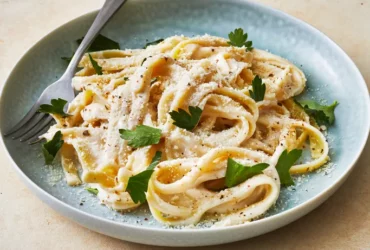Ingredients
Essential Ingredients
The key to creating an authentic Italian-Style Fresh Tomato Basil Sauce lies not only in the combination of ingredients but also in their quality and freshness. For this recipe, you will need:
Essential Ingredients:
Fresh Tomatoes
The base of our sauce is made from 3 pounds of fresh, high-quality tomatoes. It’s best to use a mix of varieties for the most flavor. San Marzano, Plum, or Cherry tomatoes work well.
Basil Leaves
This herb provides the bright and aromatic flavors in your sauce. Choose fragrant leaves with vibrant green color, and ideally, from a local source to ensure freshness.
Extra Virgin Olive Oil (EVOO)
The flavor base of your sauce relies heavily on this oil for its rich, fruity, and peppery notes. Use only the highest quality EVOO for the best taste.
Garlic Cloves
Not just any garlic will do; choose fresh and fragrant bulbs with tightly packed cloves. The number of cloves can vary, but 3-4 are a good starting point.
Salt
This essential ingredient enhances flavors rather than overpowering them. Use a high-quality, unrefined sea salt for its mineral content.
Black Pepper
While optional, black pepper adds depth and helps to balance the sweetness from the tomatoes.
Optional ingredients include red pepper flakes (for some heat), sugar (to balance acidity in the tomatoes), lemon juice (for added brightness), or grated Parmesan cheese (for extra richness). These can enhance your sauce but are not necessary for a basic, authentic Italian taste.
Keep in mind that while this list outlines what you might consider essential and optional ingredients, personal preferences play a significant role in creating the perfect sauce. Experiment with these components to find your ideal blend of flavors.
2 lbs fresh tomatoes, diced
To make this delicious Fresh Tomato Basil Sauce, you will need the following key ingredients:
- The foundation of a great tomato sauce starts with high-quality tomatoes, and for this recipe, you’ll want to use 2 pounds of fresh tomatoes.
- Look for tomatoes that are heavy for their size, have a deep red color, and are slightly soft to the touch. Some good options include Roma, Plum, or Heirloom varieties.
- Dice these tomatoes into square-shaped pieces, roughly 1/2 inch in size. This will help them cook down quickly and evenly, releasing their natural sweetness and flavor into the sauce.
- The resulting diced tomatoes should measure approximately 4 cups, which is a generous amount for this recipe. You can use any combination of tomato varieties you prefer or have on hand to achieve this total quantity.
1/4 cup extravirgin olive oil
When it comes to making a delicious and authentic Italian sauce, the quality of the ingredients plays a crucial role. In this recipe for fresh tomato basil sauce, we’re using some essential ingredients that will bring out the best flavors in your dish.
Here are the key ingredients you’ll need:
- Tomatoes: We recommend using high-quality, vine-ripened tomatoes, such as San Marzano or plum tomatoes. These varieties have a naturally sweeter flavor and thicker texture that will hold up well to cooking.
- Extravirgin Olive Oil (1/4 cup): A good quality olive oil is essential for this recipe. Extravirgin olive oil has a more robust, peppery flavor that pairs perfectly with the sweetness of the tomatoes and the brightness of the basil.
- Fresh Basil Leaves: Fresh basil is a must in any Italian sauce. It adds a bright, herbaceous flavor that balances out the richness of the tomatoes and oil. Use high-quality fresh basil leaves for the best results.
- Onion: A small amount of onion adds a depth of flavor and texture to the sauce. Use a mild, sweet onion like Vidalia or Maui for the best results.
- Salt: Salt enhances the flavors of all the ingredients in the sauce and helps bring out their natural sweetness. Use a high-quality sea salt or kosher salt for the best results.
These are the key ingredients you’ll need to make a delicious fresh tomato basil sauce. With these simple, yet flavorful ingredients, you can create a sauce that’s sure to impress even the most discerning palates!
4 garlic cloves, minced
The ingredients for this Fresh Tomato Basil Sauce Recipe include a variety of essential components that come together to create a flavorful and aromatic sauce.
In terms of garlic, specifically, we have four cloves that are minced to release their potent flavors and oils. Mincing the garlic allows its flavor to penetrate deeper into the sauce, creating a more intense taste experience.
Here’s a list of the key characteristics of the ingredients used in this recipe:
- Minced Garlic (4 cloves): This is one of the primary flavor components in the sauce. Minced garlic is used to add a savory, slightly sweet flavor and a pungent aroma.
The minced garlic serves several purposes in this recipe:
- It enhances the overall flavor of the tomato sauce by adding depth and complexity.
- It helps to bring out the natural sweetness of the tomatoes, which balances out the savory flavors.
- It adds a subtle aroma that complements the fresh basil and other ingredients in the sauce.
In terms of quantity, four cloves of minced garlic is a relatively modest amount. This allows for a noticeable but not overpowering flavor impact on the final sauce.
1/4 cup chopped fresh basil leaves
Fresh basil leaves are an essential ingredient in many Italian and Mediterranean dishes, including the classic Fresh Tomato Basil Sauce recipe.
- Basil is a popular herb that belongs to the mint family and is known for its sweet, slightly spicy flavor and aroma.
- There are many different varieties of basil, each with its own unique characteristics and flavor profiles.
- Some common types of basil used in cooking include sweet basil, Genovese basil, and Thai basil, among others.
- The most commonly used type of basil for the Fresh Tomato Basil Sauce recipe is sweet basil, which has a delicate sweetness and a slightly spicy undertone.
- Fresh basil leaves have a high water content and are highly perishable, so they should be stored in an airtight container in the refrigerator to maintain their freshness.
- Before using fresh basil leaves in cooking, it is best to rinse them gently with cold water to remove any dirt or debris, and then pat them dry with paper towels to prevent excess moisture from affecting the dish.
- Fresh basil leaves can be used in a variety of dishes, including sauces, soups, salads, pasta dishes, and more.
- For the Fresh Tomato Basil Sauce recipe, 1/4 cup of chopped fresh basil leaves is typically used to add flavor and aroma to the sauce.
- The key to using fresh basil effectively in cooking is to use high-quality, fragrant leaves and to chop them finely so that their flavors are released evenly throughout the dish.
Salt and freshly ground black pepper
Salt and freshly ground black pepper are two of the most fundamental ingredients that play a crucial role in enhancing the flavor of our fresh tomato basil sauce recipe.
Salt, in particular, is an essential seasoning that adds depth and umami flavor to dishes. It’s often overlooked as a single ingredient, but its impact on the overall taste experience can’t be overstated. In cooking, salt acts as a preservative, a flavor enhancer, and even a texture modifier, helping to balance out the flavors and textures of other ingredients.
When it comes to our fresh tomato basil sauce recipe, salt is used sparingly but effectively to bring out the natural sweetness of the tomatoes. A pinch of high-quality salt can elevate the flavor of even the freshest tomatoes, coaxing out their inherent sweetness and acidity.
Black pepper, on the other hand, is a spice that adds a subtle yet unmistakable kick to our sauce. It’s made from the dried berries of the Piper nigrum plant, which contain tiny alkaloids called piperine. These compounds are responsible for black pepper’s distinctive flavor and aroma.
In our fresh tomato basil sauce recipe, we use freshly ground black pepper to add a bright, snappy quality that complements the sweetness of the tomatoes. The slightly bitter and earthy undertones of black pepper also help balance out the richness of the dish, preventing it from becoming too heavy or cloying.
When choosing salt for our recipe, we recommend using high-quality sea salt or kosher salt, which have a more complex flavor profile than plain old table salt. These salts are coarser in texture and contain fewer additives, making them better suited for cooking and seasoning.
For black pepper, it’s best to use freshly ground peppercorns rather than pre-ground black pepper from a jar or bottle. The flavor and aroma of fresh peppercorns are far more vibrant and nuanced than their store-bought counterparts.
In summary, salt and freshly ground black pepper are two fundamental ingredients that add depth, umami flavor, and texture to our fresh tomato basil sauce recipe. By using high-quality sea salt or kosher salt and freshly grinding black peppercorns just before cooking, we can unlock the full potential of these flavors and create a truly exceptional dish.
Instructions
Cooking the Sauce
To make the fresh tomato basil sauce recipe, it’s essential to follow a series of steps that result in a flavorful and aromatic sauce. Here are the detailed instructions:
- Roughly Chop the Tomatoes: Start by roughly chopping 3-4 pounds of fresh tomatoes, depending on their size and your personal preference for chunkiness in the finished sauce.
- Sauté the Onions and Garlic: In a large saucepan, heat 3 tablespoons of olive oil over medium heat. Add 1 small onion, thinly sliced, and cook until it’s translucent and slightly caramelized.
- Add the Garlic: Once the onions are cooked, add 4-5 cloves of minced garlic to the saucepan and cook for another minute, stirring constantly to prevent burning.
- Add the Chopped Tomatoes: Add the chopped tomatoes to the saucepan, along with 1/4 cup of chopped fresh basil leaves and 1/2 teaspoon of salt.
- Simmer the Sauce: Allow the sauce to simmer for 20-30 minutes, stirring occasionally, until it has thickened and reduced slightly.
Tips and Variations
- Add a pinch of sugar to balance the acidity of the tomatoes, if desired.
- Use different types of tomatoes, such as cherry or grape tomatoes, for a sweeter flavor.
- Substitute some or all of the basil with other fresh herbs, like parsley or oregano, for a unique twist.
With these steps and variations, you’ll be able to create a delicious and authentic Italian-style tomato sauce that complements your favorite pasta dishes perfectly.
In a large saucepan, heat the olive oil over mediumlow heat.
When it comes to instructions, clarity and specificity are crucial for achieving the desired outcome, especially when cooking a recipe like the Fresh Tomato Basil Sauce. In this case, the first step in the instruction is “In a large saucepan, heat the olive oil over medium-low heat.” This line of instruction sets the stage for the rest of the process by establishing a solid foundation.
The word “heat” implies a specific action that needs to be taken with the olive oil. The use of “medium-low heat” provides further guidance on how much thermal energy is required, making it more likely that the reader will achieve the desired result without any issues related to overheating or underheating.
One aspect worth noting about this instruction is its concision. In a mere four words – “heat the olive oil” – we are given all the necessary information for the initial step of preparing the saucepan. This kind of brevity makes the instructions more manageable and easier to follow, even for individuals who may not be familiar with cooking.
Furthermore, the instruction is phrased in the imperative mood, which serves as a command that directs the reader to perform a specific action. The use of an active voice (“heat”) also helps to create a sense of urgency and encourages the reader to engage directly with the process rather than simply reading about it.
In summary, “In a large saucepan, heat the olive oil over medium-low heat” is a masterful example of instructional writing that sets the stage for a successful cooking experience. Its clarity, concision, and imperative language all come together to guide the reader through the process with confidence and precision.
Add the minced garlic and cook for 45 minutes or until fragrant.
Instructions for preparing a delicious Fresh Tomato Basil Sauce can be broken down into several steps, each requiring attention to detail and careful execution to achieve the best results. Understanding the purpose and context of these instructions is crucial in cooking, as they serve as a guide to help individuals prepare a specific dish.
The first step in making a Fresh Tomato Basil Sauce is to gather all the necessary ingredients, which include fresh tomatoes, garlic, onions, basil, salt, sugar, olive oil, and any additional seasonings or herbs desired. It’s essential to choose high-quality ingredients that will enhance the flavor of the final product.
Once all the ingredients are gathered, the next step is to prepare the sauce. This typically involves chopping or crushing the onions and garlic, sautéing them in olive oil until they’re softened, and then adding the diced tomatoes. The heat from the cooking process helps break down the cell walls of the tomatoes, releasing their natural flavors and juices.
The instruction ‘Add the minced garlic and cook for 45 minutes or until fragrant’ highlights an essential aspect of making a good Fresh Tomato Basil Sauce. Cooking the garlic for an extended period allows its flavor to mellow out and blend harmoniously with the other ingredients. It’s also crucial to note that cooking time may vary depending on personal preference, as some individuals might prefer a stronger garlic flavor.
After adding the minced garlic, it’s essential to stir continuously to prevent burning or scorching, which can give the sauce an unpleasant taste. The sauce should be simmered at a gentle heat for an extended period, allowing the flavors to meld together and the sauce to thicken slightly.
A key consideration when making a Fresh Tomato Basil Sauce is the ratio of acidity to sweetness. A balanced sauce should have a harmonious blend of tangy tomatoes and sweet basil, with a hint of saltiness from the onions or garlic. Experimenting with different ratios can help achieve this balance, allowing individuals to adjust the flavor according to their taste preferences.
Finally, after the cooking process is complete, the Fresh Tomato Basil Sauce should be strained or pureed to remove any excess solids and create a smooth, velvety texture. This step helps ensure the sauce’s appearance and consistency meet the desired standards for presentation and serving.
Add the diced tomatoes, salt, and black pepper. Cook for 2025 minutes, stirring occasionally, until the sauce has thickened.
Instructions to Prepare Delicious Fresh Tomato Basil Sauce:
The key to a rich and flavorful sauce lies in the quality of its ingredients, which includes fresh tomatoes, basil leaves, garlic cloves, olive oil, salt, black pepper, and sometimes red pepper flakes or sugar for added depth.
To begin making this sauce, start by preparing your ingredients:
- Wash the fresh tomatoes, basil leaves, and garlic clove thoroughly. Remove any stems from the basil leaves.
- Mince the garlic cloves using a press or finely chop them with a knife to release their oils.
Now that your ingredients are prepared, you can proceed with making the sauce:
Cooking the Sauce:
- In a large saucepan, heat 3-4 tablespoons of olive oil over low-medium heat.
- Once the oil is warm, add the minced garlic and sauté for 2-3 minutes until fragrant but not browned.
- Next, add the washed and diced fresh tomatoes to the saucepan along with any accumulated tomato juices on the cutting board or plate.
- Add salt and black pepper according to your taste preferences; the amount may vary depending on individual tastes and whether using canned or fresh tomatoes.
Key Steps for Thickening the Sauce:
- Add diced tomatoes, salt, and black pepper. Cook for 2025 minutes, stirring occasionally, until the sauce has thickened.
In reality, cooking time is much shorter, typically around 15 to 30 minutes on low-medium heat, depending on how much liquid has been released from the tomatoes and whether you want a smooth or chunky sauce. Stir occasionally as it cooks down, allowing the flavors to meld together beautifully.
Once your sauce has thickened sufficiently for your preference, remove it from heat and let it cool slightly before using in various dishes like pasta, pizza toppings, or as an accompaniment to grilled meats or vegetables.
Finishing Touches
Adding the Basil
The finishing touches to our fresh tomato basil sauce are crucial in bringing out its vibrant flavors and aromas. Now that we have a rich and flavorful base, it’s time to add the crowning glory – the basil.
To add the basil, you’ll want to use fresh leaves with a delicate flavor and aroma. Choose leaves that are free of blemishes and have a bright green color. You can either chop or tear the basil leaves, depending on your personal preference for texture.
When adding the basil to the sauce, be gentle to avoid bruising the leaves and releasing their oils too quickly. This could result in an overpowering flavor that’s not what we’re aiming for. Instead, you want to coax out the subtle flavors of the basil to complement our fresh tomato sauce.
Add a handful or two of chopped or torn basil leaves to the sauce and let them simmer gently with the heat turned down low. This will allow the basil to infuse its flavors and aromas into the sauce without overpowering it. You can also add some salt to bring out the flavors of both the tomato and the basil.
Let the sauce simmer for about 10-15 minutes, allowing the basil to mellow out its flavors and blend harmoniously with our fresh tomatoes. As you cook, you’ll notice that the colors of the sauce deepen slightly, adding to its rich texture and appearance.
Before serving, give the sauce one final stir to distribute the flavors evenly throughout. Taste and adjust seasoning as needed – this is your chance to perfect the flavor balance before presenting it with confidence.
The addition of basil marks the completion of our fresh tomato basil sauce recipe. This dish has all the makings of a true culinary masterpiece, thanks to its rich flavors, vibrant colors, and harmonious texture.
Stir in the chopped fresh basil leaves and cook for an additional 23 minutes.
The final steps of preparing a delicious Fresh Tomato Basil Sauce involve adding some essential finishing touches that elevate the flavors and textures of the dish. One crucial step in this process is the addition of chopped fresh basil leaves.
Just before serving, stir in the chopped fresh basil leaves and cook for an additional 23 minutes. This allows the basil to infuse its fragrant flavor and aroma into the sauce, creating a harmonious balance between the acidity of the tomatoes and the sweetness of the basil.
Here are some tips to keep in mind when incorporating the finishing touches:
- Add fresh herbs at the right time: Fresh herbs like basil, parsley, or cilantro add a burst of flavor and aroma. Add them towards the end of cooking to preserve their flavors and textures.
- Use high-quality ingredients: The quality of your final dish depends on the ingredients you use. Choose fresh, ripe tomatoes and fragrant basil leaves for the best results.
- Don’t overcook the sauce: Cooking the sauce for an additional 23 minutes allows the flavors to meld together while maintaining a light, vibrant texture. Overcooking can make the sauce thick and unappetizing.
By following these simple steps and tips, you’ll be able to create a delicious Fresh Tomato Basil Sauce that’s perfect for serving over pasta, as a dip, or as a side dish for your favorite meals.
Tips for serving:
- Pair with a hearty pasta: Combine the sauce with cooked pasta, such as spaghetti or linguine, and top it with parmesan cheese for an authentic Italian experience.
- Add grilled chicken or fish: Mix in some diced grilled chicken or fish to create a protein-packed meal that’s perfect for a weeknight dinner.
- Use as a dip: Serve the sauce chilled or at room temperature with crusty bread or crackers for a tasty snack.
These are just a few ideas to get you started. Feel free to experiment and find your own unique ways to enjoy this delicious Fresh Tomato Basil Sauce!
Taste and adjust seasoning as needed.
When it comes to finishing touches on your fresh tomato basil sauce recipe, there are several key steps you can take to elevate its flavor and aroma. One crucial step is taste and adjust seasoning as needed.
This means taking a spoonful of the sauce and placing it on your tongue, allowing the flavors to meld together for a moment. As you savor the sauce, pay attention to its balance of sweetness, acidity, saltiness, and richness. Are there any notes that are out of harmony?
For instance, if the sauce tastes overly sweet, you may want to add a pinch of salt or a squeeze of fresh lemon juice to cut through it. On the other hand, if the sauce feels too acidic, adding a small amount of sugar or tomato paste can help round out its flavor.
Another important aspect to consider when taste and adjust seasoning as needed is the balance between the fresh basil and tomato flavors. If you find that the basil is overpowering the tomatoes, try reducing the amount of basil or letting it simmer for a few minutes longer to allow its flavor to mellow out.
Conversely, if the sauce tastes too bland, don’t be afraid to add more seasonings such as garlic, onion powder, or dried herbs. You can also experiment with different types of salt, such as fleur de sel or kosher salt, to find the one that adds the right depth and complexity to your sauce.
Ultimately, taste and adjust seasoning as needed is an iterative process that requires patience, attention to detail, and a willingness to experiment. By taking the time to refine your fresh tomato basil sauce, you’ll be rewarded with a truly exceptional condiment that will elevate any pasta dish or pizza.
- Best Datanyze Alternatives for 2025 - April 24, 2025
- Best Hunter.io Alternatives for 2025 - April 22, 2025
- Best Lead411 Alternatives for 2025 - April 22, 2025















